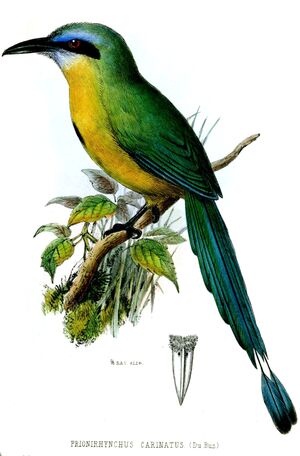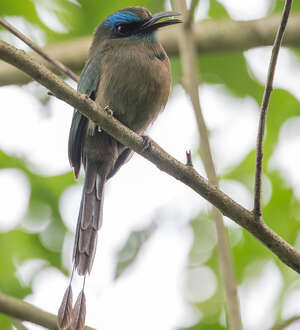Keel-billed Motmot
Electron carinatum - Motmot à bec caréné
Identification
Keel-billed Motmot, the name tells a story of its own! Bernard Amé Léonard du Bus de Gisignies (1808-1874), a Dutch ornithologist and Belgian politician, named this cousin of the Broad-billed Motmot this way in 1847. The scientific name Electron carinatum, meaning amber-golden bird with a keeled beak, refers to the upper mandible of this Motmot, which has a visible and characteristic ridge that makes it look like the keel of a ship. Let us pay tribute to Mr. du Bus de Gisignies who was able to conjure up a name that evokes this amazing bird! Electron carinatum, very similar to Electron platyrhynchum, the Broad-billed Motmot, is a small to medium-sized motmot, about 30-38 cm, with a black, long and wide beak with a rather flat aspect. The thick black loral stripe hiding the dark brown eye extends beyond the beak towards the back of the head; the forehead is brown-russet and a thick blue-turquoise eyebrow make-up the head of the Keel-billed Motmot. The crown, nape and mantle are olive green, the coverts being a darker green; the chin is of the same blue-turquoise as the eyebrows, the chest is brown-cinnamon with two black eye spots, the belly becoming paler brown and making a transition to olive on the lower part of the abdomen. The outer rectrices are grey, divided in four pairs of almost equal size with a rounded tip that give an impression of drapery; the central rectrices are blue-green with two racket-shaped endings, barred with black, which make a remarkable feature of the Keel-billed Motmot, as they are sometimes absent, either due to wear or after mating. The juveniles do not have detailed descriptions but are thought to have darker and less contrasted colourings.
Subspecific information monotypic species
Foreign names
- Motmot à bec caréné,
- Momoto carenado,
- udo-carenado,
- Kielschnabelmotmot,
- Kielsnavelmotmot,
- Motmot carenato,
- kölnäbbad motmot,
- Brunpannemotmot,
- momot kýlozobý,
- momot modrobrvý,
- Kølnæbbet Motmot,
- kanamomotti,
- motmot de bec carenat,
- piłodziób ostrodzioby,
- modroobrvi motmot,
- Ребристоклювый электрон,
- ミドリヒロハシハチクイモドキ,
- 隆嘴翠鴗,
- kölnäbbad motmot,
- 隆嘴翠鴗,
Voice song and call
The song of the Keel-billed Motmot is similar to that of the Broad-billed Motmot, issuing a deep, nasal ohhng every 3 to 5 seconds, which resembles a croaking sound; during courtship, it emits a faster ohnk-owhng.
Habitat
He frequents evergreen forests with high humidity, particularly near rivers or ravines. In Costa Rica, he remains in forests on the slopes of hills, from 700-800 meters of altitude, but he has been observed at 1,500 meters in Honduras.
Behaviour character trait
The Keel-billed Motmot is sedentary.
Dietfeeding habits
Same for its feeding habits which have not been detailed, it is assumed that its diet is similar to that of the Keel-billed Motmot, mostly insectivorous with a few amphibians and lizards.
Reproduction nesting
We know very little about Keel-billed Motmot reproduction. Males start singing from January to March, in Belize a nest was observed in Mayan ruins, but our Keel-billed Motmot usually makes its nest in a soft embankment near a wetland.
Geographic range
Threats - protection
IUCN conservation status
concern
in the Wild
threatened
evaluated
Viewed as vulnerable, BirdLife International suggests the total population is between 1,500 to 7,000 adult individuals across its range. In Mexico, it was considered extinct since 1952, yet individuals were observed in 1995 in the province of Oaxaca. Fragmentation of its range due to deforestation and population growth has put the bird in danger; it favors low-altitude wooded areas, yet no longer finds the forest it loves. Belize may be the country where it is surviving best, however, the protected zones providing refuge are fragmented and a density of around 20 individuals per 2,000 to 6,000 hectares makes it difficult for males to find mates for reproduction. The future is bleak for this wonderful Keel-billed Motmot, yet nature has sometimes unsuspected resources, and it is thought that there could be hybridization with the Tody Motmot; in Costa Rica, near the Arenal Volcano, repeated courtship between the two species has been clearly observed, will these attempts be successful?
Sources of information
- IOC World Bird List (v15.1), Gill, F and D Donsker (Eds). 2025-12-07.
- Vol. 6 - Handbook of the Birds of the World, Josep del Hoyo-Andrew Elliott-Jordi Sargatal
- Scientific Birds Names, James A.Jobling
- xeno-canto, Sharing bird sounds from around the world,
- BirdLife International, BirdLife International
- HBW Alive,
- The internet Bird Collection,
- Wikipédia, Wikipedia, The Free Encyclopedia
Other sources of interest
 Specification sheet created on
01/08/2023 by Anne et Gabriel Leboff
Specification sheet created on
01/08/2023 by Anne et Gabriel LeboffTranslation by AI Oiseaux.net
© 1996-2025 Oiseaux.net
- Accipitriformes
- Aegotheliformes
- Anseriformes
- Apodiformes
- Apterygiformes
- Bucerotiformes
- Caprimulgiformes
- Cariamiformes
- Casuariiformes
- Charadriiformes
- Ciconiiformes
- Coliiformes
- Columbiformes
- Coraciiformes
- Cuculiformes
- Eurypygiformes
- Falconiformes
- Galliformes
- Gaviiformes
- Gruiformes
- Leptosomiformes
- Mesitornithiformes
- Musophagiformes
- Nyctibiiformes
- Opisthocomiformes
- Otidiformes
- Passeriformes
- Pelecaniformes
- Phaethontiformes
- Phoenicopteriformes
- Piciformes
- Podargiformes
- Podicipediformes
- Procellariiformes
- Psittaciformes
- Pterocliformes
- Rheiformes
- Sphenisciformes
- Steatornithiformes
- Strigiformes
- Struthioniformes
- Suliformes
- Tinamiformes
- Trogoniformes




